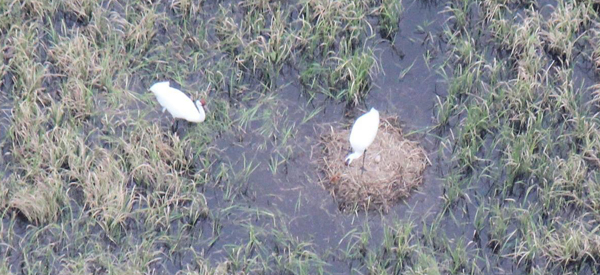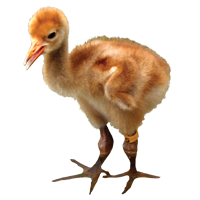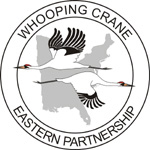 | |
| Media Contact: Joan Garland, ICF Outreach Coordinator, 608-381-1262 Update May 24th: 1+1=2! Eva confirmed yesterday that the pair has twins! View a photo of the family The Whooping Crane Eastern Partnership (WCEP) is celebrating another success in its efforts to reintroduce a wild migratory Whooping Crane population in eastern North America. A Whooping Crane chick hatched yesterday in Marathon County, Wis. The chick, #W1-13 (W = wild hatched), is the offspring of the Whooping Crane pair consisting of a female #5-10 and male #28-08 from the ultralight-guided crane Classes of 2010 and 2008. The pair nested in 2012 in Marathon County, Wis., however, after incubating past the anticipated hatch date, it was determined that their single egg was infertile. This was likely because the female was only two years old and had not yet reached breeding maturity. This spring they nested again – this time producing two eggs – one of which hatched on May 21. WCEP is hopeful the second egg will hatch very soon. “After losing 19 of 20 nests earlier this month, I was able to confirm yesterday that our single remaining nest has at least one chick,” said Eva Szyszkoski, Tracking Field Manager for WCEP and the International Crane Foundation. “During my morning survey flight on May 21, one crane was sitting on the nest in a brooding posture while the other preened nearby. Later that afternoon, one crane was still brooding while the other was off foraging in the wetland to the southeast of the nest. As the plane circled, I was able to get a visual on the tiny chick before it ducked back under the adult. The adult cranes produced two eggs this year, so hopefully we will have a little #W2-13 shortly.” Thanks to the efforts of WCEP, there are now 106 Whooping Cranes in the eastern migratory population. In addition to #5-10 and #28-08, at least three pairs are currently constructing nest platforms for what WCEP hopes will be re-nest attempts following the early May abandonment event in the core nesting area. Including #W1-13, twenty-five chicks have hatched in this population since 2006. Five of them have fledged and joined the wild population (read our update on the nesting success study of this population). Whooping Cranes were on the verge of extinction in the 1940s. Today, there are only about 600 birds in existence, approximately 445 of them in the wild. Aside from the 106 WCEP birds, the only other migratory population of Whooping Cranes nests at Wood Buffalo National Park in northern Alberta, Canada and winters at Aransas NWR on the Texas Coast. A non-migratory flock of approximately 19 birds lives year-round in the central Florida Kissimmee region, and an additional 25 non-migratory cranes live in southern Louisiana. WCEP asks anyone who encounters a Whooping Crane in the wild to please give them the respect and distance they need. Do not approach birds on foot within 200 yards; remain in your vehicle; do not approach in a vehicle any closer than 100 yards. Also, please remain concealed and do not speak loudly enough that the birds can hear you. Finally, do not trespass on private property in an attempt to view or photograph whooping cranes. Whooping Crane Eastern Partnership founding members are the International Crane Foundation, Operation Migration, Inc., Wisconsin Department of Natural Resources, U.S. Fish and Wildlife Service, the U.S. Geological Survey’s Patuxent Wildlife Research Center and National Wildlife Health Center, the National Fish and Wildlife Foundation, the Natural Resources Foundation of Wisconsin, and the International Whooping Crane Recovery Team. Many other flyway states, provinces, private individuals and conservation groups have joined forces with and support WCEP by donating resources, funding and personnel. More than 60 percent of the project’s budget comes from private sources in the form of grants, public donations and corporate sponsors. | 
Share this video with your friends and help us spread the word that disturbing, harassing or killing Whooping Cranes is a crime.
Make a gift to support Whooping Crane conservation. |



